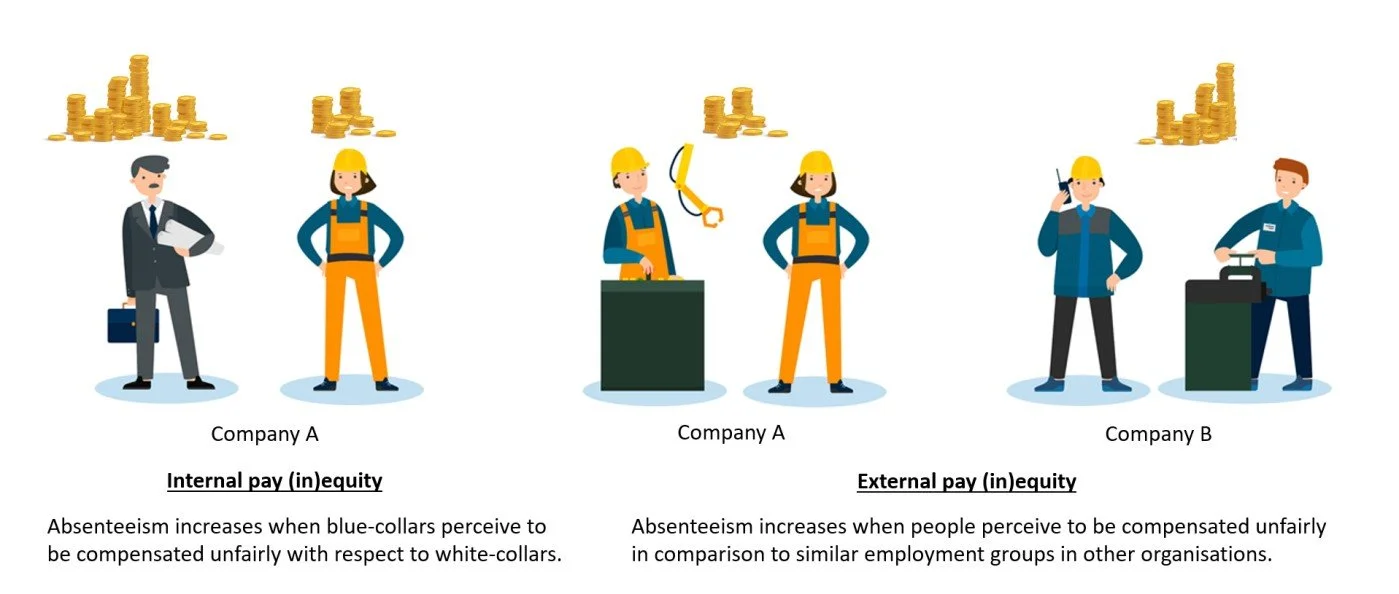Digest 39. Same or different? Internal and external pay (in)equity in organizations
Compensation systems in organizations play an important role in determining employees’ attitudes and behaviors; hence designing fair systems is like seeking the holy grail for HR professionals. When it comes to pay at work, people engage in evaluations to judge whether their returns (pay, promotions, etc.) are equitable or not. Equity theory – developed by Adams during the 1960-70s – well explains how individuals decide whether compensation is fair (or not) and what they do when they perceive equity (or inequity). In a nutshell, employees assess whether they are compensated fairly enough in return for their inputs, and they also engage in social comparisons by contrasting their inputs and returns with those of their colleagues. If people perceive an inequitable compensation, they will change their behaviors. For example, they may reduce the effort spent on the job and, consequently, job performance; they could engage in shirking behaviors such as lateness and absenteeism; or they could even leave the company.
Organizations do not exist in a void, and the external context contributes to shape a firm’s pay structure. Economic trends such as globalization, trade liberation, high permeability of the organizational internal labor market all point to the importance of considering contextual characteristics when designing compensation systems. In fact, when evaluating the fairness of their returns, employees do not only focus on pay differentials within the organization (that is, internal pay inequity), but they will also compare whether they are treated in the same way as employees doing a similar job in other organizations. The latter comparison refers to external pay inequity, indicating that individuals focus on pay differences across companies in addition to those within their organization. Now, the question is whether external and internal pay (in)equity matter evenly for individual outcomes in the workplace or… does one of the two weigh more in affecting employees’ attitudes and behaviors?
Do internal and external pay (in)equity equally matter for employee outcomes?
Della Torre and colleagues (2015) conducted a study among about 1,500 Italian manufacturing firms to understand how internal and external pay discrepancies influenced a costly organizational outcome, that is organizational-level absenteeism. To measure internal equity, they used the pay differential between occupational groups within firms, that is white- vs blue-collar employees. External inequity was measured through the pay ratio between an organization’s pay levels for blue- and white-collars versus the pay levels of other companies within the same industry.
The researchers found that both internal and external inequity matter for absenteeism at the organizational level but in different ways. External pay ratio reported a negative relationship with absences, meaning that when employees perceived to be paid fairly in comparison to people in similar jobs in other companies they reduced their absence levels. The results about the internal pay ratio showed that the levels of absenteeism were the highest when the pay ratio was in favor of white-collars, while they were the lowest when pay differences benefitted blue-collars. In other words, the two occupational groups reacted differently to perceptions of pay inequity, with only blue-collars withdrawing from their work when feeling unfairly compensated in comparison to their white-collar colleagues. Such differences can be explained by the absence norms that distinct groups develop. These norms, in turn, dictate the group’s absence behaviors.
Based on these results, the researchers went a step further and looked at whether the effect of external and internal pay inequity on absenteeism could depend on the presence of performance-based pay practices (e.g., merit pay, see Digest 38). Once again, the results differ for internal and external inequity. In relation to external pay differentials, absenteeism was found to be at its lowest when the firm relied on pay-per-performance policies. When employees perceive that they are rewarded more than people in other organizations they will strive to be present at work and reciprocate the company’s positive treatment (i.e., high pay) only if the high level of pay is contingent upon their performance. However, when it comes to the internal pay ratio, organizational absenteeism was at its highest when performance-based pay policies were in favor of white-collars (that is, pay incentives targeted white-collars and excluded blue-collars), indicating the importance of applying the same compensation policies across occupational groups.
Organizational implications
To design equitable and fair compensation systems, organizations may want to reflect on the following points:
Consider the characteristics of the organizational context, including the company’s composition in terms of occupational groups, as this will impact employees’ perceptions of and reactions to the pay structure.
Designing a compensation system with large pay discrepancies between different occupational groups inside one’s firm will have detrimental effects on organizational outcomes, such as increased absenteeism, by generating perceptions of inequity in the deprived group.
Understand the larger context and its impact on employees’ perceptions of equity and behaviors. Paying employees more than other companies in the same industry do, can be an effective strategy to reduce absenteeism at the organizational level. However, when doing so, it is important to link the level of pay to employees’ performance using appropriate policies and practices.
When using performance-based pay practices, ensure that these are consistently applied across the different occupational groups; else, these practices can backfire and damage organizational outputs (i.e., increase absenteeism of the excluded group).
——
Reference: Della Torre, E., Pelagatti, M., & Solari, L. (2015). Internal and external equity in compensation systems, organizational absenteeism and the role of explained inequalities. Human Relations, 68(3), 409-440. https://doi.org/10.1177/0018726714528730

